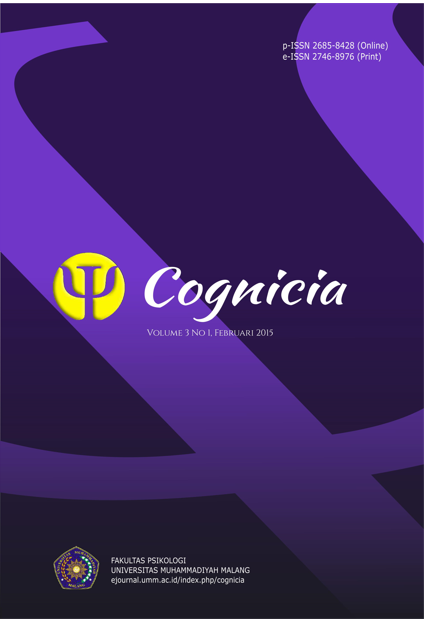MODEL PEER PRESSURE DENGAN PERILAKU KONSUMTIF PRODUK MAKANAN PADA REMAJA
DOI:
https://doi.org/10.22219/cognicia.v3i1.2144Abstract
Banyaknya jenis produk-produk makanan saat ini menjadi masalah utama pada remaja yang memiliki perilaku konsumtif dalam hal produk-produk makanan. Peer pressure merupakan salah satu faktor yang menjadi penyebabnya. Penelitian ini bertujuan untuk mengetahui hubungan antara model peer pressure dengan perilaku konsumtif produk makanan pada remaja, menggunakan desain non-eksperimen dengan pendekatan kuantitatif korelasional. Incidental sampling sebagai teknik pengambilan sampel yang dilakukan pada 311 remaja di Malang, menggunakan instrumen model peer pressure dan perilaku konsumtif produk makanan pada remaja untuk mengumpulkan data. Data di analisis dengan korelasi product moment, hasil analisis menunjukkan bahwa ada hubungan positif yang signifikan antara model peer pressure behavior dengan perilaku konsumtif makan pada remaja (r = 0,460; p = 0,000), ada hubungan positif yang signifikan antara model peer pressure normative regulation dengan perilaku konsumtif makan pada remaja (0,245; p = 0,000). Tidak ada hubungan antara model structuring opportunities dengan perilaku konsumtif produk makanan (r = 0,025; p = 0,664). Semakin tinggi model peer pressure, perilaku konsumtif produk makanan akan semakin tinggi juga.
Kata kunci: model peer pressure, perilaku konsumtif produk makanan
Many food products are currently being major problem in adolescents as they had consumptive behavior for food products. Peer pressure was one of many factors behind it. This study aimed to determine the correlation between peer pressure model with consumptive behavior for food products in adolescents, using non-experimental design with correlation quantitative research. Incidental sampling as sampling techniques was conducted to 311 adolescents in Malang, using peer pressure model and consumptive behavior for food products instrument to collect the data. Data was analyzed using correlation product moment, the result showed that there was significant positive correlation between peer pressure model behavior with excessive food product behavior in adolescents (r = 0,460; p = 0,000). There was significant positive correlation between peer pressure model normative regulation with excessive behavior for food product in adolescents (r = 0,245; p = 0,000). There was not significant correlation between peer pressure structuring opportunities model with excessive behavior for food product in adolescents (r = 0,025; p = 0,664). As peer pressure model was higher, consumptive behavior for food product would be high as well.
Keywords: Model peer pressure, consumptive food product behavior
Downloads
Downloads
Published
How to Cite
Issue
Section
License
Copyright (c) 2015 Muhammad Rizky Khadafi

This work is licensed under a Creative Commons Attribution-ShareAlike 4.0 International License.
Authors who publish with Jurnal Cognicia agree to the following terms:
- For all articles published in Jurnal Cognicia, copyright is retained by the authors. Authors give permission to the publisher to announce the work with conditions. When the manuscript is accepted for publication, the authors agree to automatic transfer of the publishing right to the publisher.
- Authors retain copyright and grant the journal right of first publication with the work simultaneously licensed under a Creative Commons Attribution-ShareAlike 4.0 International License that allows others to share the work with an acknowledgment of the work's authorship and initial publication in this journal.
- Authors are able to enter into separate, additional contractual arrangements for the non-exclusive distribution of the journal's published version of the work (e.g., post it to an institutional repository or publish it in a book), with an acknowledgment of its initial publication in this journal.
- Authors are permitted and encouraged to post their work online (e.g., in institutional repositories or on their website) prior to and during the submission process, as it can lead to productive exchanges, as well as earlier and greater citation of published wor (See The Effect of Open Access).

This work is licensed under a Creative Commons Attribution-ShareAlike 4.0 International License







